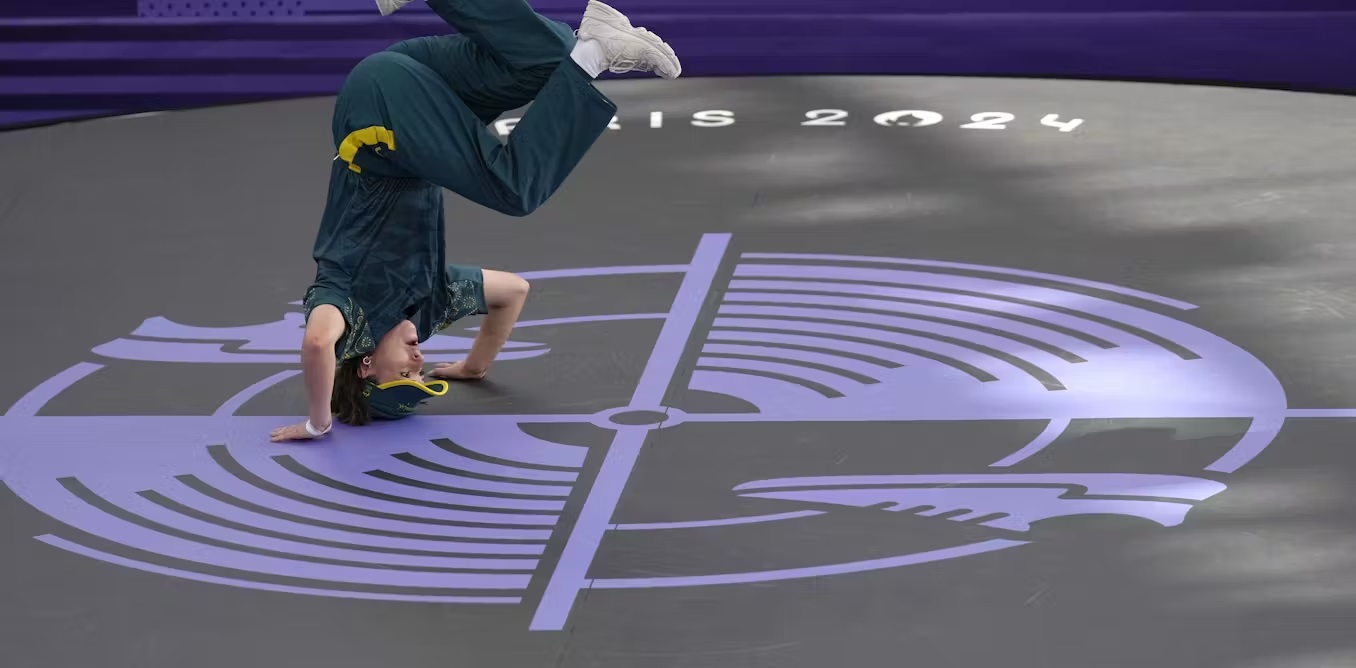Raygun is Australia’s most famous dancer today. What does she say about our own attitude to dance?
by Jeanette Mollenhauer, The University of Melbourne
The inclusion of the breakdancing competition in the 2024 Olympic Games has certainly caused a stir. And now Australian competitor Rachael Gunn (known as “Raygun”) is one of the most famous Olympians of any nation – and Australia’s most famous dancer, too.
Her performance sparked a flood of (often negative) social media memes, comments and bullying. However, her teammates showed their support. Australian rower Angus Widdicombe even carried Gunn on his shoulders on the day of the closing ceremony.
The Queen has arrived for the closing ceremony. pic.twitter.com/LYMJidfJS1
— Jack Snape (@jacksongs) 11 August 2024
Raygun’s Olympic story offers Australians an opportunity to question their attitudes to dance. Was their dancing, for example, so out of place in a nation whose cultural symbol is the nutbush?
Yes, Australia has impressive professional companies like the Australian Ballet, Sydney Dance Company and Bangarra Dance Theatre, but Raygun has put community-based dance in the spotlight. She has also forced Australia to question its own attitudes towards the different forms and functions of dance. And that’s your best move, B-girl!
A nation of shy dancers
Why do Australians think dancing is primarily about performance rather than participation? We get up and sing off-key at karaoke, but shy away from dancing in public. Creative Australia’s recent arts event participation report shows that while one in six Australians are involved in music, only one in ten dance regularly. It seems we’re just not a nation of recreational dancers.
In 2007, Australian dance writer Lee Christofis – a child of Greek immigrants – asked the question: “Why can’t the ‘English’ teach their children to dance?” He could not understand why there were no community dance activities among his Anglo-Australian neighbours.
His observation still rings true today, with Creative Australia’s 2023 report showing that both ethnic minority Australians (25% compared to 8% of non-ethnic minority Australians) and ethnic minority Australians (17% compared to 6% of non-ethnic minority Australians) are more likely to dance than Anglo-Australians.
Perhaps Anglo-Australians have been conditioned to think that “dance” means only what we see on stage and screen – that it is something reserved for people with the physique and flair of Paul Mercurio in Strictly Ballroom (1992).
The communal roots of dance
Unless they are thinking of the Nutbush, white Australians do not usually associate “dance” with “community” in the way that First Nations and CALD Australians do. But the reality is that dance has always been about community, politics and expression, as well as technique and athleticism.
In her own article for The Conversation, Gunn described how breakdancing originated in the Bronx, New York, among African-American and Puerto Rican youth before being adopted in other countries.
And it is not the only social dance form that has been co-opted for mass entertainment. Tap dancing also has African and Irish-American roots and has been incorporated into mainstream dance practice. Twerking is another example of a style with African roots that has been popularized by Western mass media.
Yet despite the adoption of dances from various other cultures, Western societies still consider classical ballet and contemporary dance to be the pinnacle of the dance world. The Sydney Morning Herald’s dance section focuses on these two styles – and probably shapes public opinion. Certainly, media reviews can make or break a performer or troupe, either attracting or repelling audiences.
In Australia, it is difficult for anyone who does not practice ballet and contemporary dance to receive sufficient government funding. The money often does not make it past the stage to the dancers at the grassroots level – to those who enjoy folk, swing, square or, of course, breakdancing.
In Gunn’s own words:
(In) Australia, there wasn’t the same level of investment. (…) I never had the slightest chance of beating those B-girls at what they do, so I did what I do best and went out there and showed myself, my creativity, my style, a bit of Australian character so I could try and make my mark on that world stage.
The reaction to Raygun’s performance is about dance, but also about national expectations: With Australia nearing the end of its most successful Games ever, a score of zero is simply not what people wanted to hear.
@samyahafsaoui Going to see Adele means seeing a really good comedy show with incredible live music #adeleinmunich #raygun #olympics
♬ Original sound – Samya Hafsaoui
Raygun got the whole world talking
Even before the games in Paris, it was clear that breaking would no longer be used at the 2028 Olympic Games in Los Angeles – the country where breaking originated. Gunn was not happy with this news.
She is a dance scholar focusing on cultural politics in breakdancing. Her research focuses on gender imbalances in breakdancing. One of her early articles briefly refers to her dancing as a way of expressing “Australianness”. Perhaps this approach inspired her costume and choreography for Paris?
Although her routine wasn’t well received by everyone, Gunn was defended by AusBreaking, other Olympians and even Prime Minister Anthony Albanese, who applauded her for sticking to the “Australian tradition of people trying.”
The viral Australian breakdancer “Raygun” (@TheRealDratch) Jimmy’s monologue crashes! 🤣 #FallonTonight pic.twitter.com/A1uaetO1sY
— The Tonight Show (@FallonTonight) 13 August 2024
Overall, Gunn has given Australia a lot to talk about. The aftermath of her Olympic performance has revealed a lot about our own attitudes to dance – and the fact that we don’t engage with it as much as we should. She has also put breakdancing on the map worldwide – and she should be congratulated for both.
Jeanette Mollenhauer, Honorary Member (Dance), Faculty of Fine Arts and Music, The University of Melbourne
This article is republished from The Conversation under a Creative Commons license. Read the original article.

